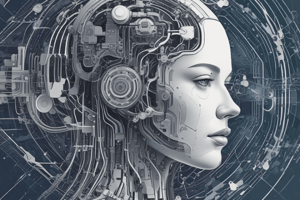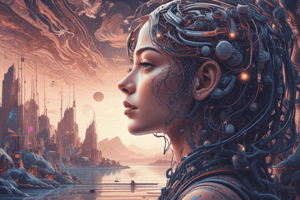Podcast
Questions and Answers
What is Computer Vision (CV)?
What is Computer Vision (CV)?
- The ability for machines to interpret and understand the visual world around us. (correct)
- The extraction of useful information from text data.
- The use of neural networks to recognize patterns in images.
- A subfield of robotics dealing with movement control.
Which technique has been crucial in recent advances in Computer Vision?
Which technique has been crucial in recent advances in Computer Vision?
- Quantum Computing
- Deep Learning (correct)
- Blockchain Technology
- Genetic Algorithms
What can Computer Vision systems do besides identifying objects?
What can Computer Vision systems do besides identifying objects?
- Analyze text data and extract meaningful insights.
- Predict financial market trends.
- Control robotic arms with precision.
- Recognize patterns and understand relationships within images. (correct)
How has Transfer Learning benefited Computer Vision?
How has Transfer Learning benefited Computer Vision?
What is the primary benefit of combining Computer Vision (CV) with other modalities like audio and text data?
What is the primary benefit of combining Computer Vision (CV) with other modalities like audio and text data?
In the context of CV applications, what does 'Object Detection' refer to?
In the context of CV applications, what does 'Object Detection' refer to?
What is a significant limitation faced in the field of Computer Vision (CV) related to data?
What is a significant limitation faced in the field of Computer Vision (CV) related to data?
How can Computer Vision (CV) help in the field of Medical Imaging?
How can Computer Vision (CV) help in the field of Medical Imaging?
What is a common concern associated with the robustness of AI systems in Computer Vision?
What is a common concern associated with the robustness of AI systems in Computer Vision?
In the future, what areas are highlighted as promising applications of Computer Vision (CV)?
In the future, what areas are highlighted as promising applications of Computer Vision (CV)?
Flashcards are hidden until you start studying
Study Notes
Artificial Intelligence and Computer Vision: Shaping our Visual World
Artificial Intelligence (AI) has revolutionized the way we process and interact with visual information. One of its most fascinating subfields is Computer Vision (CV), the ability for machines to interpret and understand the visual world around us. As AI continues to evolve, CV is becoming increasingly essential, driving innovation in areas such as healthcare, security, and gaming.
From Pixels to Insights: How CV Works
Computer Vision systems use algorithms to analyze images and videos to extract useful information. These algorithms can identify objects, recognize patterns, and understand relationships within an image. They can also track motion, estimate depth, and predict future states based on visual data. Beyond basic recognition, CV has the potential to analyze human emotions, detect cancer cells, and even create realistic synthetic images.
Pushing the Limits: Recent Advances in CV
Recent progress in CV can be attributed to the following key areas:
- Deep Learning: The use of neural networks has enabled computers to recognize patterns at an unprecedented level of complexity. This has led to the creation of deep learning models such as convolutional neural networks (CNNs) and recurrent neural networks (RNNs).
- Transfer Learning: Pretrained models can be fine-tuned to solve new problems, reducing the need for large amounts of labeled data.
- Multi-Modal Learning: Combining CV with other modalities like audio and text data allows for more robust learning and better decision-making.
Examples of CV Applications
- Image Classification: AI is used to categorize images into different classes, such as identifying specific objects or scenes.
- Object Detection: AI can identify and localize objects within an image.
- Face Recognition: AI can identify and authenticate individuals based on their facial features.
- Self-Driving Cars: AI can process visual data from cameras to sense road conditions, detect obstacles, and navigate safely.
- Medical Imaging: AI can help radiologists analyze medical images faster and more accurately, potentially improving diagnosis and treatment.
Limitations and Challenges of CV
- Data Collection: To train AI systems, large datasets are required. However, collecting and labeling data can be expensive and time-consuming.
- Robustness: AI systems must be able to withstand real-world variations, such as different lighting conditions, occlusions, and extreme weather.
- Privacy: As AI systems become more sophisticated, there is a growing concern about privacy and security.
- Ethical Considerations: AI systems must be developed and used in a responsible and equitable manner.
The Future of CV
As AI continues to evolve, CV is poised to have an even greater impact on our lives. Enhanced realism in gaming and virtual reality, more efficient medical diagnoses, safer transportation, and improved security are just a few of the promising applications on the horizon.
Computer Vision is not only transforming the world of AI but also pushing the boundaries of what is possible in visual processing. With ongoing research and development, we can expect even more remarkable advancements in the near future.
Studying That Suits You
Use AI to generate personalized quizzes and flashcards to suit your learning preferences.




